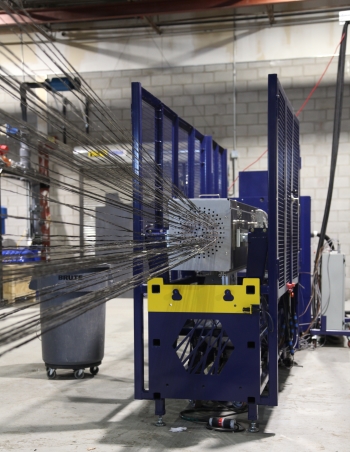Blogue
Mass produced hockey sticks… from braids!?


PhD student Maissaloun El-Jakl, who works in Professor Louis Laberge Lebel's laboratory, is developing part of a mass production-oriented braiding and pultrusion process for composite hockey stick handles. (Photo : Martin Primeau)
Braided hockey sticks? This is Professor Louis Laberge Lebel's (Department of Mechanical Engineering) ambitious project at Polytechnique Montreal. By pairing an industrial braiding machine with a pultruder, he's potentially changing the production game in terms of the speed at which hockey sticks can get into the hands of players everywhere. He and his team also plan to lay the foundations for a new industry in Quebec - mass producing braided composite hockey stick handles.
February 2020: in China, the SARS-CoV2 virus (which causes COVID-19) has disrupted numerous supply and manufacturing chains. Such is the case for composite-material hockey sticks, where the closure of the Bauer and CCM factories in Asia leave the shadow of a high-end hockey stick shortage in North America. Even National Hockey League (NHL) players are worried.
Meanwhile, on this side of the planet, Polytechnique Montréal's Professor Louis Laberge Lebel is sporting quite a grin: the professor in the Department of Mechanical Engineering has just received a much anticipated email from the Natural Sciences and Engineering Research Council of Canada (NSERC). The national research fund granting body, as well as PRIMA Quebec, have given their green light for the start of an ambitious project - developing a new process to manufacture composite material hockey sticks.
 Professor Louis Laberge Lebel (PHOTO : Caroline Perron) Professor Louis Laberge Lebel (PHOTO : Caroline Perron) |
Why try to reinvent the wheel - or in this case, the hockey stick manufacturing process? Because making a traditional thermoset composite hockey stick handle isn't very easy these days. Each piece is shaped via moulding - first composites are crushed against the walls of a mould by an inflatable bladder, then the tube is heated to around 125 degrees Celsius. “It's a job that is very physically difficult for workers,” explains Professor Lebel. “Then, there's several more steps that must be carried out by hand."
The professor - a former Bombardier and Pratt and Whitney engineer - thinks that in few short years, he'll have an alternative to offer to hockey stick manufacturers. This alternative would permit automation of stick manufacturing, by using a time-tested process which from the automotive and aeronautic sector: "pultrusion."
At a glance... pultrusion |
|
A contraction of the English verb "to pull" and the manufacturing process "extrusion," the word pultrusion refers to a manufacturing process wherein material is pulled through a series of dies in order to be coaxed into a desired shape. The process has been around since the 1950s, and was first used to manufacture long parts, such as tubes and profiles made of metal or fiberglass. More recently, the process has begun to use composite materials. “The biggest advantage of pultrusion, is that it permits continuous production. You could almost leave the device running 24/7 - all you have to do is cut the piece once you get the size you want," explains Professor Laberge Lebel. Notably, this technique is used to manufacture structural beams made of fiberglass or composite materials. Such as? Ladders for electricians: their fiberglass uprights are often manufactured by pultrusion. |
Pulling... Braids
 The pultruder that the group is using to prepare its hockey stick manufacturing process. (Photo : Martin Primeau) The pultruder that the group is using to prepare its hockey stick manufacturing process. (Photo : Martin Primeau) |
On paper, it makes sense to use pultrusion to make composite stick handles - but when really thinking about the process, the road to pultrusion hockey stick handles is still a ways off.
Before taking shape courtesy a pultruder, the to-be-stick must first be braided. This is how it all begins: carbon threads are combined with other threads in a thermoplastic resin base, in order to form a hybrid thread used for braiding. These braids will then be heated immediately after they take on their characteristic rectangular tube shape. ...and these are just a few of the many steps it takes!
Professor Laberge Lebel's team will soon be pairing an industrial braiding machine to its pultruder at their Anjou facilities. Once the operation is complete, the real work of optimizing the various stages will begin. It's a process that promises to be long, given the number of parameters that need to be optimized.
"If you want continuous production, you have to pay attention to every detail. We have to be able to produce the stick handles quickly, but without compromising product quality," notes Professor Laberge Lebel.
Which combination of glass yarns, carbon yarns, and polymer are the best choice? How should they be braided into handles that are both flexible and resistant? How can you make a tubular braid into a uniform rectangular tube? Which braiding angles are the most suitable?
These are just some of the many questions that four graduate students and one postdoctoral fellow are already focusing on to move the project forward. There are simply so many parameters to be set, that there are far more players in the lab than would be allowed on the ice at any given time without a penalty. Note that if you want in on the action, another student will eventually be added to the group - Professor Laberge Lebel would be happy to get your CV, if you're interested in the project.
For her part, doctoral student Maissaloun El-Jakl is focused on another aspect to the project – how to identify which low carbon footprint materials should be privileged. Add to that, what combination of magical low-carbon material(s) can be used to produce hockey sticks. It's not exactly a straightforward question.
“We want to coat the wires with a thermoplastic polymer that can be repaired or recycled, but the problem is that this type of material is very viscous, and you have to find a way to impregnate the threads so that they're evenly covered," explains El-Jakl.

PhD student Félix Lessard will soon be testing his own pultrusion manufacturing process for part of a passenger seat intended for the aeronautical industry. (PHOTO: Martin Primeau)
Made in Quebec Hockey sticks |
 Made in Québec hockey sticks could at some point find their way into the hands of professional hockey players. (Photo: Eyesplash, CC BY-NC-ND 2.0) Made in Québec hockey sticks could at some point find their way into the hands of professional hockey players. (Photo: Eyesplash, CC BY-NC-ND 2.0)Professor Louis Laberge Lebel and his team's project could lead to the creation of an ecosystem for manufacturing hockey sticks in composite materials in Québec. Blainville's Bauer Canada is already involved in the project, as are Saint-Bruno's specialist Pultrusion Technique, and Sherbrooke composite textile designer FilSpec. |
Learn More
Professeur Louis Laberge Lebel's expertise
Department of Mechanical Engineering website






Comments
Commenter
* champs obligatoire